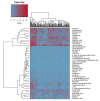Gut Microbiota as a Source of Uremic Toxins
- PMID: 35008909
- PMCID: PMC8745165
- DOI: 10.3390/ijms23010483
Gut Microbiota as a Source of Uremic Toxins
Abstract
Uremic retention solutes are the compounds that accumulate in the blood when kidney excretory function is impaired. Some of these compounds are toxic at high concentrations and are usually known as "uremic toxins". The cumulative detrimental effect of uremic toxins results in numerous health problems and eventually mortality during acute or chronic uremia, especially in end-stage renal disease. More than 100 different solutes increase during uremia; however, the exact origin for most of them is still debatable. There are three main sources for such compounds: exogenous ones are consumed with food, whereas endogenous ones are produced by the host metabolism or by symbiotic microbiota metabolism. In this article, we identify uremic retention solutes presumably of gut microbiota origin. We used database analysis to obtain data on the enzymatic reactions in bacteria and human organisms that potentially yield uremic retention solutes and hence to determine what toxins could be synthesized in bacteria residing in the human gut. We selected biochemical pathways resulting in uremic retention solutes synthesis related to specific bacterial strains and revealed links between toxin concentration in uremia and the proportion of different bacteria species which can synthesize the toxin. The detected bacterial species essential for the synthesis of uremic retention solutes were then verified using the Human Microbiome Project database. Moreover, we defined the relative abundance of human toxin-generating enzymes as well as the possibility of the synthesis of a particular toxin by the human metabolism. Our study presents a novel bioinformatics approach for the elucidation of the origin of both uremic retention solutes and uremic toxins and for searching for the most likely human microbiome producers of toxins that can be targeted and used for the therapy of adverse consequences of uremia.
Keywords: chronic kidney disease; microbiome; uremia; uremic toxins.
Conflict of interest statement
The authors declare no conflict of interest.
Figures


Similar articles
-
The Impact of CKD on Uremic Toxins and Gut Microbiota.Toxins (Basel). 2021 Mar 31;13(4):252. doi: 10.3390/toxins13040252. Toxins (Basel). 2021. PMID: 33807343 Free PMC article. Review.
-
Compositional characteristics of the gut microbiome in patients with uremia.Indian J Pathol Microbiol. 2025 Jan 1;68(1):42-50. doi: 10.4103/ijpm.ijpm_554_23. Epub 2024 Jul 13. Indian J Pathol Microbiol. 2025. PMID: 39011618
-
Association of Sarcopenia and Gut Microbiota Composition in Older Patients with Advanced Chronic Kidney Disease, Investigation of the Interactions with Uremic Toxins, Inflammation and Oxidative Stress.Toxins (Basel). 2021 Jul 8;13(7):472. doi: 10.3390/toxins13070472. Toxins (Basel). 2021. PMID: 34357944 Free PMC article.
-
Evaluation of the impact of gut microbiota on uremic solute accumulation by a CE-TOFMS-based metabolomics approach.Kidney Int. 2017 Sep;92(3):634-645. doi: 10.1016/j.kint.2017.02.011. Epub 2017 Apr 8. Kidney Int. 2017. PMID: 28396122
-
The Microbiome and Uremic Solutes.Toxins (Basel). 2022 Mar 30;14(4):245. doi: 10.3390/toxins14040245. Toxins (Basel). 2022. PMID: 35448854 Free PMC article. Review.
Cited by
-
Guanidino acid hydrolysis by the human enzyme annotated as agmatinase.Sci Rep. 2022 Dec 21;12(1):22088. doi: 10.1038/s41598-022-26655-4. Sci Rep. 2022. PMID: 36543883 Free PMC article.
-
Comparison of the gut microbiota in older people with and without sarcopenia: a systematic review and meta-analysis.Front Cell Infect Microbiol. 2025 Apr 28;15:1480293. doi: 10.3389/fcimb.2025.1480293. eCollection 2025. Front Cell Infect Microbiol. 2025. PMID: 40357398 Free PMC article.
-
An Extensively Hydrolyzed Formula Supplemented with Two Human Milk Oligosaccharides Modifies the Fecal Microbiome and Metabolome in Infants with Cow's Milk Protein Allergy.Int J Mol Sci. 2023 Jul 13;24(14):11422. doi: 10.3390/ijms241411422. Int J Mol Sci. 2023. PMID: 37511184 Free PMC article. Clinical Trial.
-
Therapeutic Potential of Photobiomodulation for Chronic Kidney Disease.Int J Mol Sci. 2022 Jul 21;23(14):8043. doi: 10.3390/ijms23148043. Int J Mol Sci. 2022. PMID: 35887386 Free PMC article. Review.
-
Emerging role of the host microbiome in neuropsychiatric disorders: overview and future directions.Mol Psychiatry. 2023 Sep;28(9):3625-3637. doi: 10.1038/s41380-023-02287-6. Epub 2023 Oct 16. Mol Psychiatry. 2023. PMID: 37845499 Free PMC article. Review.
References
-
- Levin A., Tonelli M., Bonventre J., Coresh J., Donner J.-A., Fogo A.B., Fox C.S., Gansevoort R.T., Heerspink H.J.L., Jardine M., et al. Global kidney health 2017 and beyond: A roadmap for closing gaps in care, research, and policy. Lancet. 2017;390:1888–1917. doi: 10.1016/S0140-6736(17)30788-2. - DOI - PubMed
-
- Vanholder R., De Smet R., Glorieux G., Argilés A., Baurmeister U., Brunet P., Clark W., Cohen G., De Deyn P.P., Deppisch R., et al. Review on uremic toxins: Classification, concentration, and interindividual variability. Kidney Int. 2003;63:1934–1943. doi: 10.1046/j.1523-1755.2003.00924.x. - DOI - PubMed
MeSH terms
Substances
Grants and funding
LinkOut - more resources
Full Text Sources

